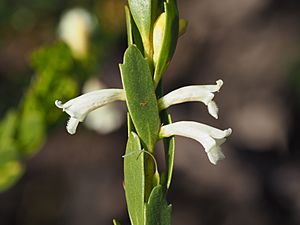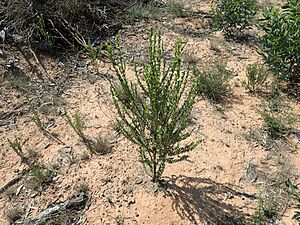Eremophila compressa facts for kids
Quick facts for kids Eremophila compressa |
|
|---|---|
 |
|
| E. compressa growing near Salmon Gums | |
| Conservation status | |
| Scientific classification | |
| Genus: |
Eremophila (plant)
|
| Species: |
compressa
|
Eremophila compressa is a special kind of flowering plant. It belongs to the figwort family. This plant only grows in a small part of Western Australia. It's a straight-growing shrub. Its leaves have a few noticeable "teeth" near their tips. The flowers are usually white or cream-colored.
Contents
About the Plant
Eremophila compressa is a shrub that grows upright. It can reach a height of about 0.8 to 2 meters (2.6 to 6.6 feet). Its branches are smooth, but they have many small, lumpy spots. The ends of the branches are often sticky because of a natural resin.
The leaves grow one after another along the stem. They point upwards, sometimes hiding the branches. They are green, but can sometimes have a purple tint. The leaves are shaped like an oval or an egg. They are usually 8 to 16 millimeters (0.3 to 0.6 inches) long. They are also 2 to 7 millimeters (0.08 to 0.3 inches) wide. Each leaf has 2 or 3 clear "teeth" near its tip.
Flowers and Fruit
The flowers grow either alone or in pairs. They appear where the leaves meet the stem. Each flower sits on a small stalk, about 1 to 3.5 millimeters (0.04 to 0.14 inches) long. There are 5 small, smooth, green parts called sepals. These are about 1 to 2 millimeters (0.04 to 0.08 inches) long.
The petals are joined together at their bottom to form a tube. This tube is 6 to 10 millimeters (0.2 to 0.4 inches) long. The petal tube is white or cream-colored. Its outside is smooth, but the inside is covered with long, soft hairs. The top part of the bottom petal also has hairs. The 4 stamens (which hold pollen) are completely hidden inside the petal tube.
Eremophila compressa usually flowers from July to December. After flowering, it produces oval-shaped fruits. These fruits are smooth and about 1 millimeter (0.04 inches) long.
How it Got its Name
This plant was first officially described in 1986. A scientist named Robert Chinnock gave it its name. He published his description in a science journal called Nuytsia. The first plant specimen used for the description was found by Chinnock near Salmon Gums.
The second part of its name, compressa, comes from a Latin word. It means "compressed" or "flattened." This name refers to the shape of the plant's fruits.
Where it Lives
Eremophila compressa grows in a specific area of Western Australia. You can find it between the towns of Ravensthorpe, Grasspatch, and Norseman.
It prefers to grow in areas with disturbed clay or sandy loam soils. These areas are part of the Esperance Plains and Mallee regions.
Protecting the Plant
The Government of Western Australia's Department of Parks and Wildlife has given Eremophila compressa a special status. It is listed as "Priority Three."
This means that we don't know a lot about this plant yet. It is only found in a few places. However, it is not currently in immediate danger of disappearing. Scientists keep an eye on these plants to make sure they stay safe.
Growing Eremophila compressa
People can grow Eremophila compressa in gardens. It can grow up to 2 meters (6.6 feet) tall and almost as wide. It flowers for a long time, which makes it a nice plant to have. Its open, somewhat thin growth style is also unique.
You can start new plants from cuttings (small pieces of the plant). You can also grow it by grafting it onto other Myoporum plants. It grows well in most types of soil. It likes full sun or a bit of shade. This plant can handle frost and doesn't need a lot of water once it's established.



